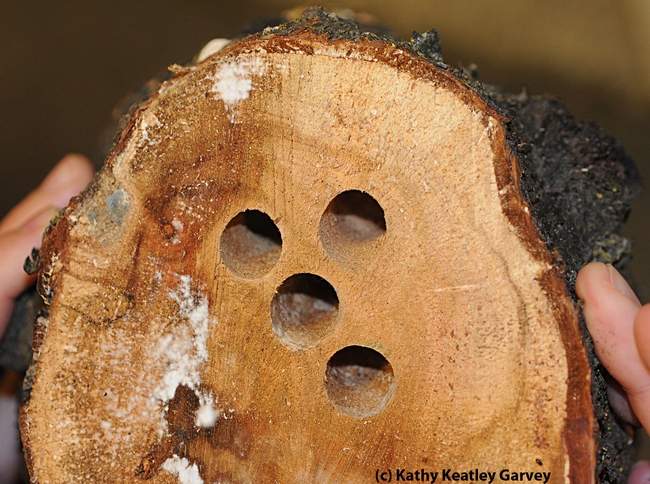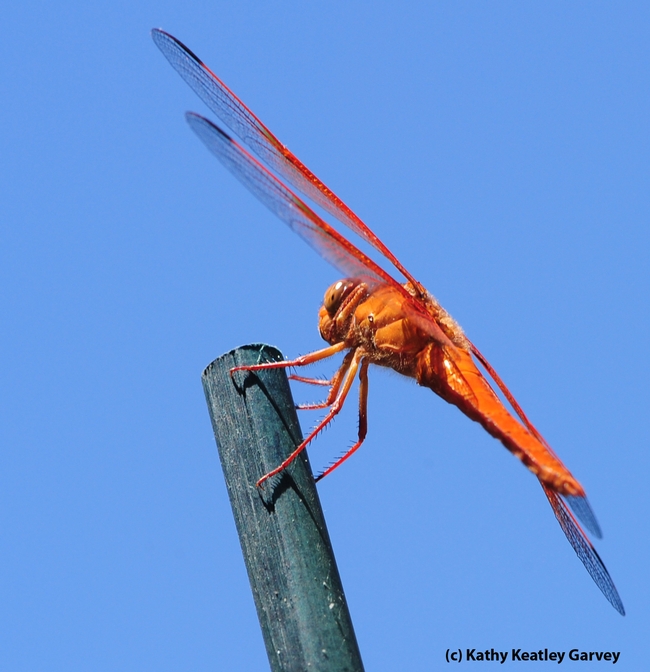- Author: Kathy Keatley Garvey
Occasionally we see a honey bee on the violet trumpet vine (Clytostoma calystegiodies) but the hummingbirds seem to like it better.
The delicate purple-veined blossoms burst out in late spring or summer. It's a UC Davis Arboretum All-Star.
What is an All-Star? According to the UC Davis Arboretum website: "The horticultural staff of the UC Davis Arboretum have identified 100 tough, reliable plants that have been tested in the Arboretum, are easy to grow, don’t need a lot of water, have few problems with pests or diseases, and have outstanding qualities in the garden. Many of them are California native plants and support native birds and insects. Most All-Star plants can be successfully planted and grown throughout California."
Arboretum officials list some 100 All-Stars on their website, and they periodically hold public plant sales at their teaching nursery on Garrod Drive. The last sale took place May 18.
As for the violet trumpet vine, it's one of the stars in the Häagen-Dazs Honey Bee Haven, a half-acre bee friendly garden next to the Harry H. Laidlaw Jr. Honey Bee Research Facility on Bee Biology Road, UC Davis. The garden is open to the public for self-guided tours from dawn to dusk. Neither the UC Davis Arboretum nor the haven charges admission for self-guided tours.

- Author: Kathy Keatley Garvey

On every field trip, we see something new and different, such as the male long-horned bee, Melissodes communis (below) on salvia and the female sunflower bee, Svastra obliqua expurgata, on a Mexican hat flower.
With so much interest in pollinators, it's good to see that biologist Beatriz Moisset has written a downloadable book, "A Beginners Guide to Pollinators and other Flower Visitors." It's meant for young adults and beginners.
Moisset, a resident of Willow Grove, Penn., received her doctorate in biology from the University of Cordoba, Argentina. She completed her postdoctoral work at the Jackson Laboratories, Bar Harbor, Maine, studying neurochemistry and behavior.
She's "retired," but like so many dedicated biologists, she's not. She's a talented artist, photographer, author and public speaker.
Moisset's book, available for a nominal price, covers the most common flower visitors, including pollinators. It includes brief descriptions, illustrations, geographic distribution, habitat and season.
You'll find her insect photography and text on BugGuide.Net and on her pollinator blog, http://pollinators.blogspot.com/. Check out her amazing photos!
And her book? It's available through Barnes and Noble, Lulu.com, and ITunes.
We remember that back in 2011, she teamed with entomologist Stephen Buchmann, who received his doctorate in entomology in 1978 from UC Davis (his major professor was Robbin Thorp), to publish the USDA Forest Service/Pollinator Partnership publication, "Bee Basics: An Introduction to Our Native Bees" with illustrator Steve Buchanan. (Just click on the link to download.)
The more we know about our native bees and the flowers they pollinate, the more we can protect them.
"We are all part of the web of life," Moisset writes on her blog. "Animals need plants and plants need animals and ultimately we all need each other in a very intricate and complex web of interactions."
So true.


- Author: Kathy Keatley Garvey
If you're craving to find out more about insects--specifically how to FIND them--then you'll want to attend the Bohart Museum of Entomology’s open house from 1 to 4 p.m., Sunday, June 9.
It's free and open to the public.
Insects aren't difficult to find in the Bohart Museum, which is located in Room 1124 of the Academic Surge building on Crocker Lane, UC Davis. After all, the museum houses nearly eight million specimens.
You'll also be able to find them outside. You'll learn how to net and trap insects at a demonstration site at the side of the building.
Another highlight will be how to rear cabbage white butterflies. You'll be given a free pamphlet on how to rear cabbage whites. Many classroom teachers try to rear monarch butterflies, but there's a growing movement to raise cabbage whites instead. After all, cabbage whites are more abundant, easily obtained and quite easy to rear. Their host plants include cabbage, broccoli, kale, cauliflower and mustards.
The transformation of an egg to a caterpillar to a chrysalis to an adult can not only be witnessed in the classroom, but at your home as a family project.
At the open house, you can also hold such live specimens as Madagascar hissing cockroaches and walking sticks. The gift shop (which now accepts credit cards) includes t-shirts, jewelry, insect nets, posters and books, including the newly published children’s book about California's state insect. “The Story of the Dogface Butterfly,” a 35-page book geared toward kindergarteners through sixth graders, was written by UC Davis doctoral candidate Fran Keller and illustrated (watercolor and ink) by Laine Bauer, a 2012 graduate of UC Davis. It also includes photos by naturalist Greg Kareofelas of Davis, a Bohart Museum volunteer. Net proceeds from the sale of this book go directly to the education, outreach and research programs of the Bohart Museum. The book also can be ordered online.
This is the last of the open houses for the 2012-13 academic year. Bohart officials schedule weekend open houses throughout the academic year so that families and others who cannot attend on the weekdays can do so on the weekends. The Bohart’s regular hours are from 9 a.m. to noon and from 1 to 5 p.m., Monday through Thursday. The insect museum is closed to the public on Fridays and on major holidays. Admission is free.
The Bohart Museum, directed by Lynn Kimsey, professor of entomology at UC Davis, is the seventh largest insect collection in North America. It is also the home of the California Insect Survey, a storehouse of the insect biodiversity. Noted entomologist Richard M. Bohart (1913-2007) founded the museum in 1946.
For further information, contact Tabatha Yang, education and outreach coordinator at tabyang@ucdavis.edu or (530) 752-0493.

- Author: Kathy Keatley Garvey
If you've studied bees, you know that there are approximately 20,000 described species of bees in the world.
Most people are familiar with honey bees and bumble bees, but they don't know about "those big black bees" (carpenter bees) or "those green metallic bees" (sweat bees).
Harvard University and the Encyclopedia of Life to the rescue!
Jessica Rykken, Ph.D. of the Farrell lab at Harvard University, and editor Jeff Holmes, Ph.D. of the Encyclopedia of Life, Harvard University, have just published a field guide to bees that is simply outstanding.
The field guide, titled "Bees," is comprised of observer cards that are "designed to foster the art and science of observing nature," Rykken writes.
It's a guide that looks at bees much the way we all first started looking at bees. It's divided into anatomy, foraging, lifestyles, pollination, nesting habits, behavior, life cycle, associations (such as hitchhiking) and techniques (collecting and conservation).
Under nesting habits, you'll learn about the miners, masons, leafcutters and carpenters.
Under anatomy, you'll learn about body plan, look-alikes, size and shape, body color, antennae, wings, males ves females, pollen transport, tongue length, pilosity, stingers. Pilosity? What's that you ask? It means the density and pattern of hair on their bodies.
Lifestyles? No, not of the rich and famous. These point to social bees, solitary bees and cuckoo bees.
Rykken asked permission to use two of our photos, and they're in there, too. One is of Extension apiculturist Eric Mussen of the UC Davis Department of Entomology being stung by a honey bee (Apis mellifera), and the other is a chunk of plum tree wood drilled by valley carpenter bees (Xylocopa varipuncta). A Davis resident brought the plum tree wood into the Bohart Museum of Entomology for insect identification. Lynn Kimsey, director of the Bohart Museum (home of nearly 8 million specimens) and UC Davis professor of entomology, told him that valley carpenter bees (females) drilled the holes. The female valley carpenter bees are solid black, while the males are blond with green eyes.
The field guide can be downloaded for free on the Encyclopedia of Life website at http://eol.org. Or, just download this link to the PDF.


- Author: Kathy Keatley Garvey
It's a bird, it's a plane...
It's not Superman. It's a flame skimmer dragonfly (Libellula saturata).
We spotted this dragonfly in our yard recently and crouched down for a low angle, framing it against the sky.
This is one insect that everyone notices and admires.
Except maybe its prey...



